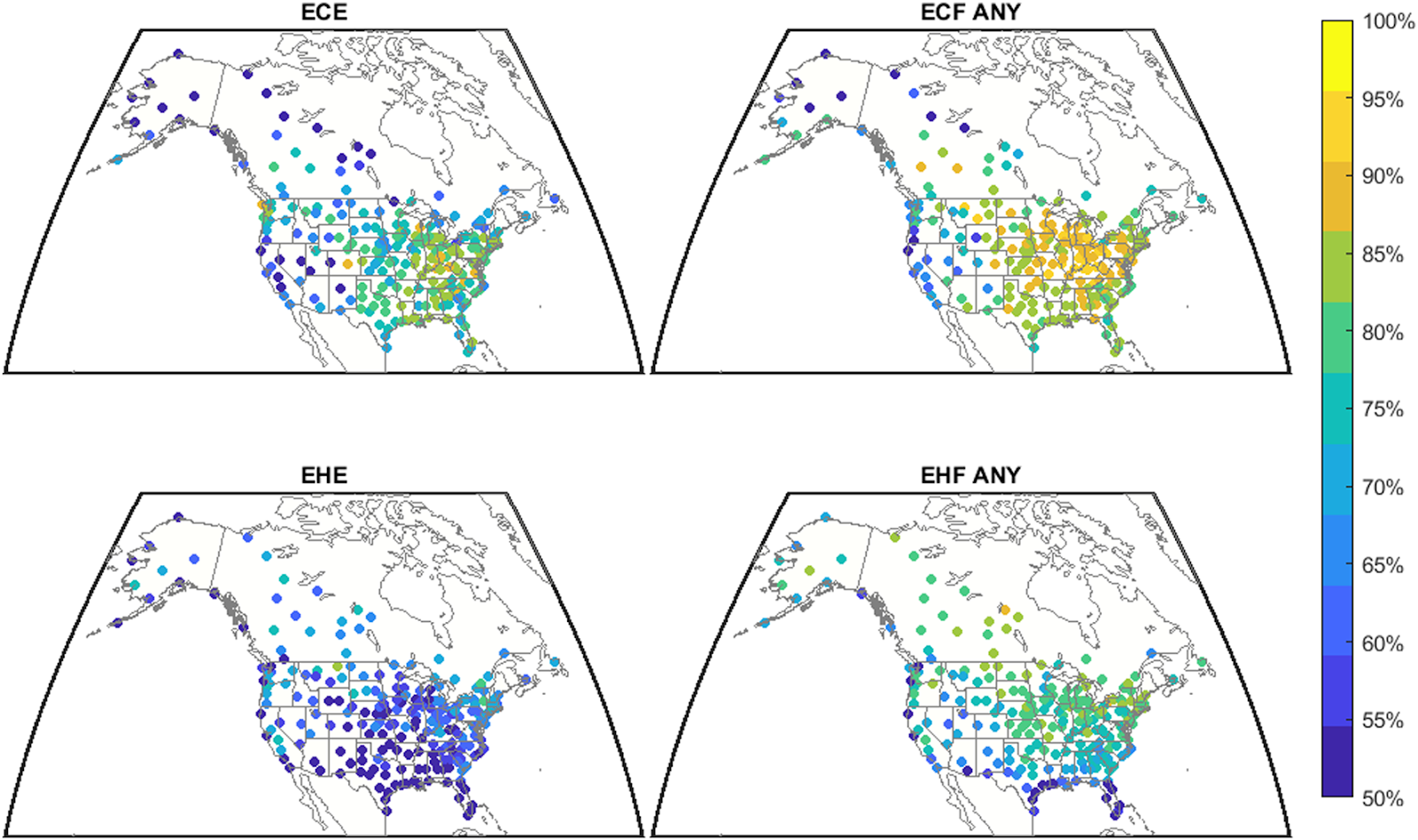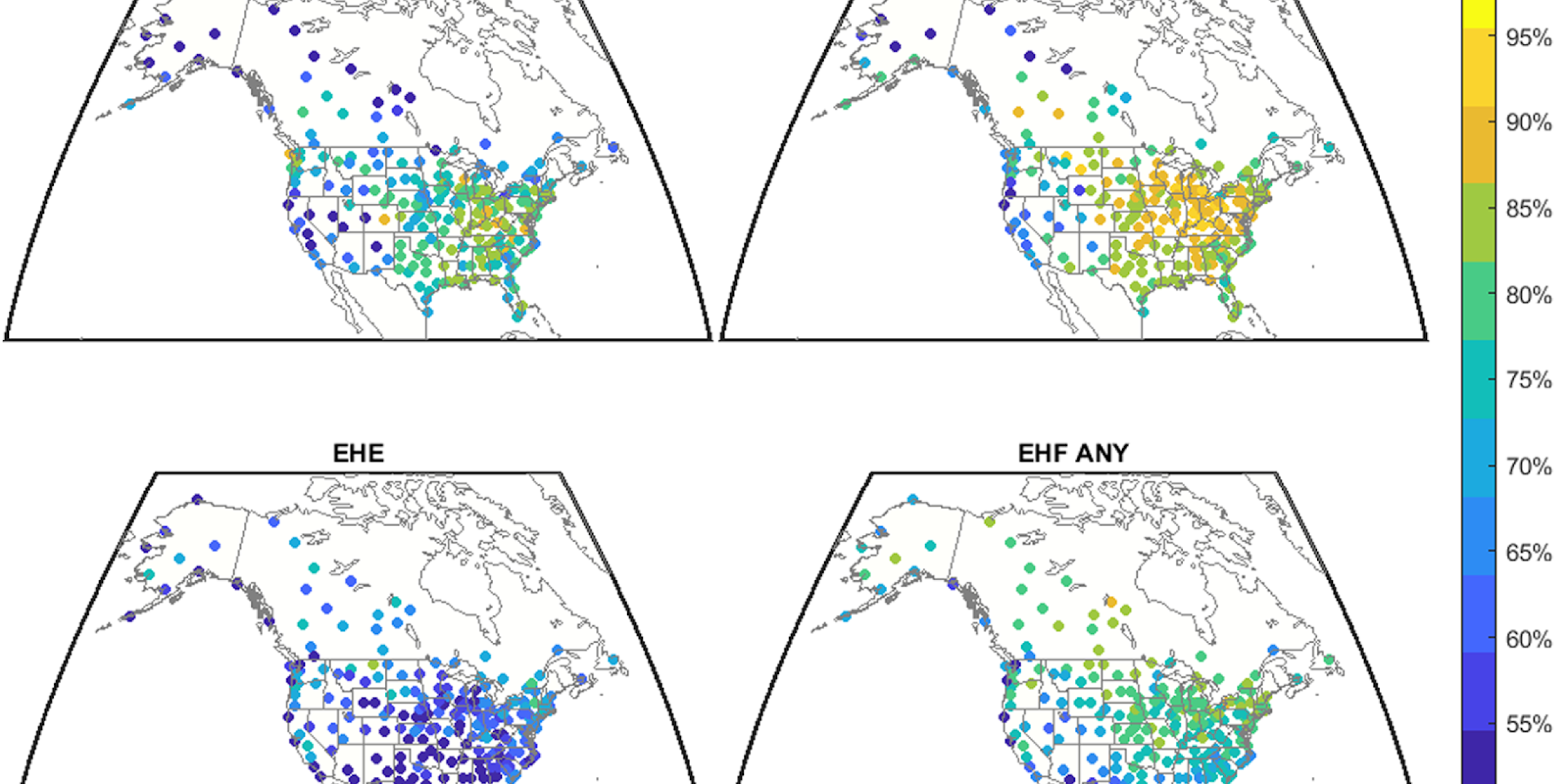

Figure 2 of the paper, showing match percentage between station-defined extreme temperature vents (ETEs) and those defined using the NARR reanalysis product.
Extreme temperature events (ETEs), whether very hot or very cold, can have dramatic impacts on both humans and our environment. For example, extreme heat events are one of the leading weather-related causes of death in the US.
On-the-ground weather stations record ETEs as they happen and provide information about ETEs for a specific location. However, observation stations lack the spatial scale to observe ETEs across large regions. On the other hand, atmospheric reanalysis products, which are historical simulations of the atmosphere that can be visualized as a gridded overlay across the surface of the Earth, have continuous spatial coverage. Atmospheric reanalyses are an important tool for climate research, but they have known inconsistencies and they do not effectively utilize ground station data. Given their increasing usage in studies examining extreme heat, it’s important to understand how well and how consistently reanalysis datasets identify ETEs.
Geographers at Kent State University, with funding from the NOAA Climate Program Office’s Climate Observations and Monitoring (COM) Program, recently released a study which explores how accurately a set of reanalysis datasets identify ETEs compared to surface stations. This study, published in Geophysical Research Letters, matches extreme heat and extreme cold events captured from 1979-2016 by weather stations across 230 locations in the US and Canada with those identified by three reanalysis datasets (ERA5, ERA5-LAND, and the NOAA-produced NARR).
The study found that reanalysis datasets can broadly replicate the same spatial patterns of ETEs as station data in terms of when and where they occur; however, with more matches for cold events than heat events, there is clear discrepancy between the reanalyses and station observations for event type. Arctic areas, coastal areas, and areas with complex terrain show the greatest discrepancies. ERA5, which is the only reanalysis product to directly integrate surface observations into its climate model, had the greatest overall match percentage with station data in terms of identifying ETEs. ERA5 identified 80.1% of the same ETEs as defined by the observational weather stations. ERA5-Land and NARR matched station data 73.6% and 68.9% of the time, respectively. The authors speculate that ERA5-Land had better match performance than NARR due to its higher spatial resolution and newer bias correction and parameterization schemes. Though the fact that their differences were most noticeable in topographically complex areas suggests that spatial resolution may matter more in this case than model physics. The authors found no significant improvement over time in match percentage for any of the reanalysis datasets.
ETEs were identified using an Apparent Temperature (AT) index in order to account for the effects of variables like dew point and wind speed. The study examined both absolute extreme heat and extreme cold events as well as relative extreme heat and extreme cold events (i.e. events considered extremely hot or extremely cold relative to the time of year they occurred). Interestingly, the thresholds of extreme heat and extreme cold were defined using 1981-2010 data, which resulted in a greater sample of frequent extreme heat events identified for 2011-2016.
In general, extreme cold events were found to be most frequent in the midwestern US and Rocky Mountains, and least frequent in the southern US and other coastal regions. Extreme heat events were most frequent across the southern US and least frequent farther north. Relative extreme cold events occurred with similar frequency across North America, except for in the northeastern US and eastern Canada where they were less frequent. Relative extreme heat events were also equally common, except for being more frequent in some areas of the High Plains.
Extreme cold events were most often identified by both station data and reanalysis products (NARR had a 72% match, ERA5-LAND 74% and ERA5 81.4%). Continental locations with little topography (i.e. flat) had the best match percentages. Areas south of the Great Lakes, coastal plains, and Arctic-facing northern locations had noticeably lower match percentages for extreme cold events. There were fewer overall matches between reanalysis and station datasets for extreme heat events, especially for NARR (57.5% overall match, 63.9% for ERA5-Land, and 72.2% for ERA5). Match percentage for extreme heat events showed the worst performance throughout the southern and eastern US as well as the Pacific Coast.
Relevative extreme cold events and relative extreme heat events broadly mirrored the match percentages of their absolute counterparts, though NARR did perform substantially worse in Canadian Rockies with relative extreme heat events while, at the same time, improving considerably across the midwest.



